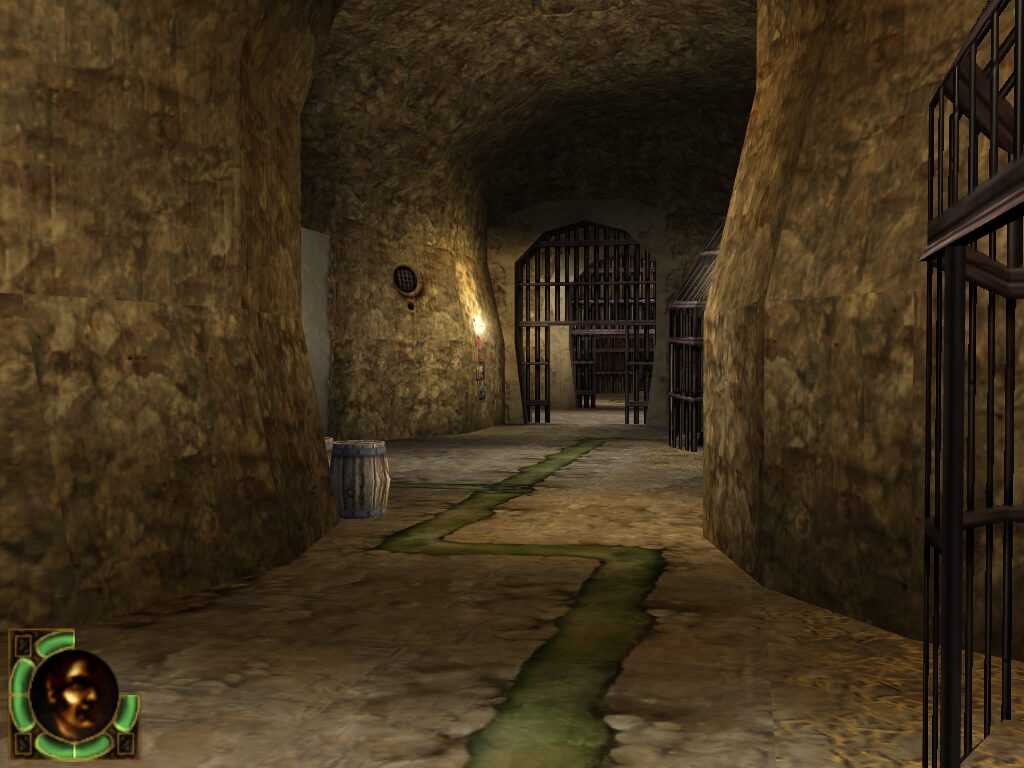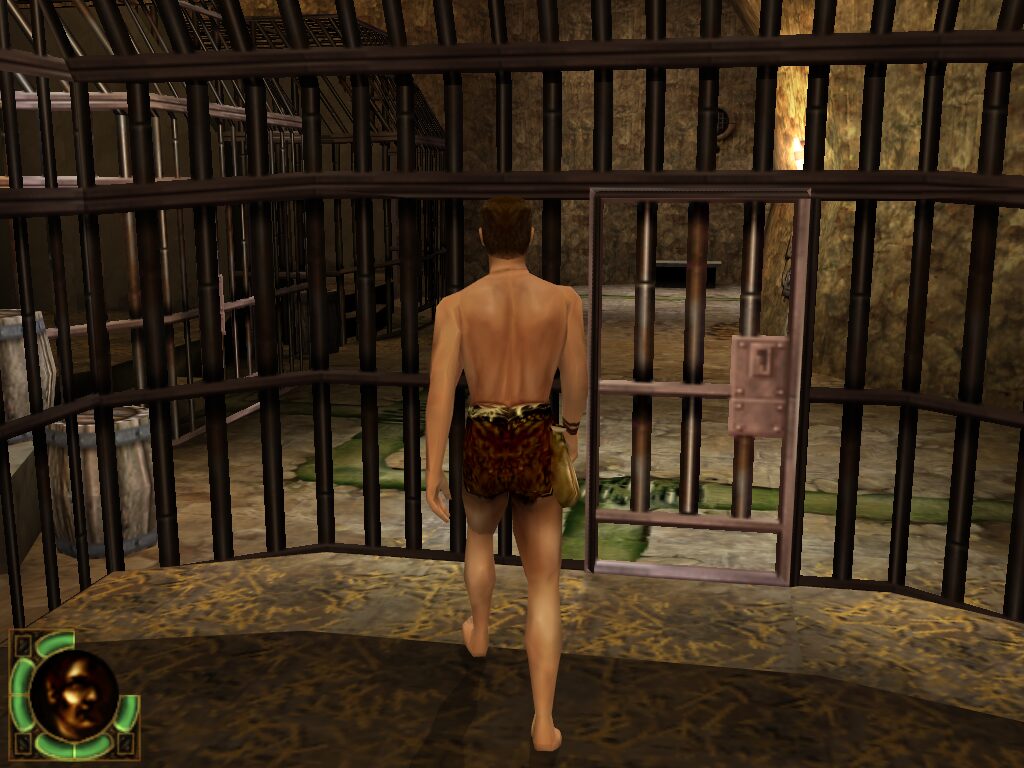Retro Replay Review
Gameplay
Planet of the Apes puts you squarely in the loincloth of Ulysses, a resourceful human stranded on an ape-dominated world. From the third-person vantage point, the controls feel tight and responsive, whether you’re sprinting across cliff edges or engaging in brutal brawls. Traversal often requires a blend of basic acrobatics—leaping across ruins and shimmying up walls—and a steady eye for environmental cues. These platforming sections serve as both a showcase for level design and a test of your timing.
Combat is deceptively simple at first, relying on context-sensitive punches, blocks, and throws, but it evolves into a satisfying system as you unlock more advanced maneuvers. Early encounters with patrol-like chimpanzees teach you to dodge and exploit openings, while higher-tier apes wield staffs or cut you off with multiple strikes, forcing you to think on your feet. Despite the absence of weapons beyond improvised clubs or rocks, each skirmish feels earned, as you must rely on block-parry-attack rhythms more than raw button mashing.
Puzzles are woven organically into the gameplay loop. You may need to persuade a friendly orangutan to share vital intel, piece together broken machinery to unlock a gate, or arrange primitive pulley systems using your wits rather than an in-game hint system. Though some puzzles border on trial and error, most are intuitive if you pay attention to environmental storytelling. The pacing between stealth, dialogue, combat, and puzzle-solving keeps monotony at bay, making every segment feel purposeful.
Graphics
Visually, Planet of the Apes captures an otherworldly atmosphere without leaning on flashy effects. The native forests glow with an emerald hue at dawn, while the crumbling ape citadels showcase weathered stone pillars and overgrown vines that hint at a civilization reclaiming nature. Textures are detailed for their time, with mossy surfaces and chipped tiles lending authenticity to each corridor you explore. Even on lower-end hardware of its era, the game maintains stable framerates in most environments.
Character models for ape factions stand out thanks to expressive facial animations and realistic fur shaders. Friendlies bear nuanced features—a tilt of the head or subtle eyebrow raise—that breathe life into non-human NPCs. Enemy apes, particularly guards and elites, tower over Ulysses with an intimidating presence, reinforced by snarls and aggressive body language that telegraph attack patterns. Motion capture seems to have been sparingly used, but the outcome is convincing enough to pull players into the struggle for survival.
Lighting and shadow play pivotal roles in building suspense. Dimly lit corridors become tense arenas when enemy patrols lurk around corners, while open plazas under moonlight transform into breathtaking vistas. Color grading remains consistent: muted earth tones dominate, punctuated by occasional warm glows from torches or distant firelight. Though the game doesn’t push the envelope with post-processing filters, its aesthetic choices reinforce the sense of a world reclaimed by apes.
Story
Planet of the Apes takes inspiration from the 1968 original and the 2001 remake’s visual palette but forges its own narrative path. As Ulysses, you carry the weight of humanity’s last hope but have few resources beyond cunning and diplomacy. The opening scenes—your crash-landing and hurried capture—set an urgent pace that never fully dissipates, as you constantly weigh risk versus reward when interacting with various ape factions.
Dialogue unfolds through branching conversations where tone matters. Will you plead for mercy, bluff your way through a confrontation, or remain silent and let your actions speak? These choices influence short-term alliances and unlock alternate puzzle paths, although the overall narrative arc remains linear. Supporting characters, such as a sympathetic orangutan medic or a cynical gorilla guard, grow on you as they reveal motivations shaped by this world’s brutal hierarchy.
The storyline builds to a climactic revelation that ties back to the franchise’s iconic themes of power, prejudice, and the fragility of civilization. While some plot twists may feel predictable to die-hard fans, the game compensates with emotionally charged moments—like rescuing captive humans or thwarting an uprising—delivered through punchy cutscenes and in-engine cinematics. Ultimately, you’re drawn deeper into the struggle for coexistence, rooting for Ulysses as he seeks not only survival but also redemption.
Overall Experience
Planet of the Apes excels at weaving its gameplay, graphics, and narrative into a cohesive package that respects its source material without rehashing old beats. The blend of stealth, puzzle-solving, and hand-to-hand combat keeps the action varied, while the detailed environments invite exploration. Even occasional camera quirks or checkpoint hiccups feel like minor blemishes in an otherwise polished adventure.
This title is best suited for players who appreciate atmospheric world-building and moderate challenge. If you relish games where thinking ahead matters as much as reflexes—and you’re intrigued by a fresh take on the ape-ruled dystopia—Planet of the Apes will deliver hours of engrossing gameplay. However, those expecting large-scale battles or complex RPG mechanics may find the focus on raw survival and tight encounters more humble in scope.
In sum, stepping into Ulysses’s sandals offers an experience that’s both familiar to fans of the franchise and unique in its execution. With its engaging story beats, solid combat framework, and evocative environments, Planet of the Apes stands as a worthy addition to any gamer’s library—especially if you’re drawn to science fiction worlds where every decision can mean life or death.
 Retro Replay Retro Replay gaming reviews, news, emulation, geek stuff and more!
Retro Replay Retro Replay gaming reviews, news, emulation, geek stuff and more!









Reviews
There are no reviews yet.